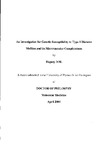An Investigation for Genetic Susceptibility to Type 1 Diabetes Mellitus and its Microvascular Complications
| dc.contributor.author | Hegazy, D.M. | |
| dc.contributor.other | School of Biomedical Sciences | en_US |
| dc.date.accessioned | 2013-10-22T12:08:33Z | |
| dc.date.available | 2013-10-22T12:08:33Z | |
| dc.date.issued | 2004 | |
| dc.identifier | NOT AVAILABLE | en_US |
| dc.identifier.uri | http://hdl.handle.net/10026.1/2293 | |
| dc.description.abstract |
Long-term exposure to diabetes mellitus is associated with metabolic abnormalities such as chronic hyperglycemia and redox imbalance. Uncontrolled hyperglycaemia and genetic factors are implicated in the pathogenesis of diabetic microvascular diseases. Genetic mutation through the genes coding for enzymes involved in glucose metabolism and immuno-regulatory mechanisms may contribute to the susceptibility to type I diabetes mellitus (TIDM) and its chronic microvascular diseases. Previous studies have shown that the transcription factor, nuclear factor kappa 8 (NFκB) and heat shock proteins (HSPs) are two redox-sensitive cellular responses of most immune and inflammatory diseases including diabetes and its late vascular complications. NFκB promotes the transcription of a wide array of proinflammatory mediators and adhesion molecules. HSPs are proposed to have a cytoprotective effect; in contrast they have the capacity to promote pathogenic processes. In this study, polymerase chain reaction (PCR)-based microsatellite analysis and restriction fragment length polymorphism (RFLP) analysis were used to genotype the genes coding for NFκB, HSP70-A2, sorbitol dehydrogenase (SORD) and protein kinase C- β(PKC-β). The A10 allele of the NFκB gene and H3 and H7 alleles of the HSP70-A2 gene were identified as risk markers of TIDM (P< 0.01). These alleles were not associated with microvascular complications. No evidence of associations was obtained between either PKC-β or SORD genes with TIDM and its late complications. Uncontrolled hyperglycaemia may alter the transcription mechanism of many genes, which control vascular homeostasis. The electrophoresis mobility shift assay (EMSA) was used to assess the transcription factor, heat shock factor-1 (HSF-1) and NFκB-DNA binding activity in response to a concentration of 31 mM D- glucose in peripheral blood mononuclear cells (PBMCs) from patients with TIDM with and without microvascular complications. Hyperglycaemia induced significant increases in both NFκB and HSF-1-DNA binding activities in PBMCs from patients (p= 0.003 and 0.017 respectively). The protein activity was more pronounced in PBMCs from patients with microvascular complications. Hyperglycaemia-induced NFκB-DNA binding activity was correlated to that of HSF-1 (p< 0.0 I). Patients with TIDM with microvascular complications demonstrated a significant increase in NFκB-DNA binding activity compared to patients with a short duration of diabetes (SD) or diabetic controls (DC) (p= 0.003 and p = 0.047 respectively). A significant positive correlation was found between the duration of diabetes and hyperglycaemia-induced NFκB-DNA binding activity (p=0.035). These results suggest that hyperactive flux through the polyol pathway is relevant to hyperglycaemia-induced protein activity since the aldose reductase inhibitors (ARIs) zopolrestat and sorbinil reduced HSF-1 and NFκB-DNA binding activity in PBMCs. In conclusion, these results suggest that NFκB and HSP70-A2 genes may contribute to the genetic susceptibility to TIDM. Uncontrolled hyperglycaemia in diabetes may alter the transcription mechanism and magnify the proinflammatory responses, which accelerate the development of diabetic microvascular complications. | en_US |
| dc.language.iso | en | en_US |
| dc.publisher | University of Plymouth | en_US |
| dc.title | An Investigation for Genetic Susceptibility to Type 1 Diabetes Mellitus and its Microvascular Complications | en_US |
| dc.type | Thesis | |
| dc.identifier.doi | http://dx.doi.org/10.24382/1547 | |
| dc.identifier.doi | http://dx.doi.org/10.24382/1547 |
Files in this item
This item appears in the following Collection(s)
-
01 Research Theses Main Collection
Research Theses Main


